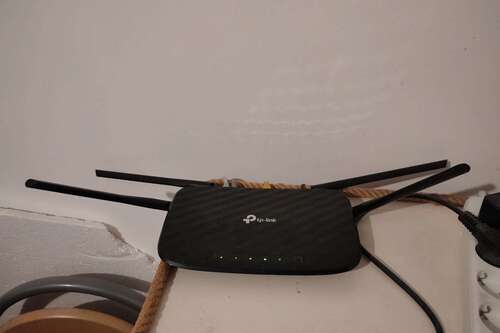Key Takeaways
- Angling your Wi-Fi antennas can improve your signal coverage by strategically directing the signal.
- If angling the antennas doesn’t solve coverage issues, you might need a proper Wi-Fi range extender or mesh Wi-Fi system for significantly better coverage and signal strength.
Nobody likes a patchy Wi-Fi signal around their house. Interrupted video streams are annoying on their own, and things only get worse if you live with multiple people. However, before you blame it on the quality of your router and chuck it out, first try angling your antennas.
How Does the Angle of Your Antennas Improve the Signal?
The Wi-Fi signal emitted from the antennas is omnidirectional, which means that the signal travels to all sides equally. The signal radiates in the shape of a fat donut from all sides of the antenna. However, a donut is mostly flat, meaning you don’t get that much coverage in the vertical space. That’s why you get a very strong Wi-Fi signal when sitting in another room, but your connection dips the moment you go downstairs, even if you’re directly below the router.
Adjusting your antenna by angling it or laying it horizontally will move the whole “donut,” so the signal will now travel more vertically. There’s a good reason why most Wi-Fi routers now come with multiple adjustable antennas—you get more flexibility with how and where you focus the signal.
Technically speaking, angling your antennas won’t make your Wi-Fi signal faster and stronger. Instead, it allows you to choose where to send the signal and optimize your Wi-Fi coverage. Still, you can use the angles to your advantage to focus the signal into a specific area of the house and get a more stable and potentially faster Wi-Fi signal.
How to Find the Best Antenna Orientation for You
If you want to eliminate dead zones—the areas that have poor or no Wi-Fi signal—you’ll have to use some trial and error. The good news is that you can get a pretty good idea of where the signal will go before having to test it.
The tip of the antenna doesn’t point to where the signal goes. The signal is emitted from the sides, so it’s actually the exact opposite. As you can see from this picture, I angled my router antennas in a way to get more vertical coverage. The signal is perfect in the room where the router is, and thanks to the angled antennas, I get a very strong signal downstairs as well.
If your router is in the kitchen downstairs, and you need a strong signal for your game console, orient the sides of each antenna so they face the direction of the console. This way, you’ll get more coverage in your room, and your kitchen should still get a strong signal, thanks to the proximity of the router.
If you’re still not happy with the coverage or have stubborn dead zones, try doing further tests using a Wi-Fi signal app. Just go to the dead zone, test the signal strength, make slight adjustments to your router antennas, retest the signal, and repeat if necessary.
Maybe It’s Time to Get a Wi-Fi Range Extender
While angling your antennas is definitely something you should do to get better coverage immediately, it’s not a one-stop-shop solution. If you can’t get a strong Wi-Fi signal in some rooms, no matter where you place the router, a Wi-Fi range extender provides a convenient way to boost your signal. It does exactly what it says on the tin—it takes your current Wi-Fi signal and extends its range.
While having one or two Wi-Fi range extenders doesn’t typically cause congestion issues or a weak signal, you should still seriously consider getting a mesh Wi-Fi system, especially if you have a large house and need the best coverage possible. If that sounds like you, check out our list of the Best Mesh Routers.


